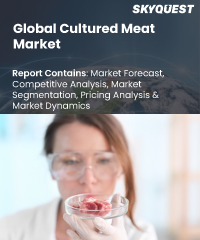
Report ID: SQMIG30I2374

Report ID:
SQMIG30I2374 |
Region:
Global |
Published Date: February, 2024
Pages:
198
|
Tables:
122 |
Figures:
77
North America is a key market for cultured meat, driven by a strong focus on sustainability and increasing consumer demand for alternative protein sources. The region has witnessed significant investments and collaborations in the cultured meat industry, contributing to its growth. The United States, in particular, has emerged as a major player, with several cultured meat startups and established companies leading the market. The regulatory environment in North America has been relatively supportive of cultured meat, further fueling its adoption.
Europe is at the forefront of the cultured meat market, with countries such as the Netherlands and Germany leading the way. The region has a strong emphasis on sustainable agriculture and reducing the environmental impact of food production. European consumers have shown a high level of acceptance for cultured meat products, with initiatives and partnerships between research institutions, startups, and food companies driving market growth. Regulatory frameworks in Europe are being developed to address the safety and labeling requirements for cultured meat.
The Asia Pacific region holds immense growth potential in the cultured meat market. Countries like Japan, Singapore, and South Korea are actively investing in the development and commercialization of cultured meat technologies. The region's high population, increasing disposable income, and changing dietary preferences make it a promising market for alternative protein sources. Additionally, concerns about food security, sustainability, and the environmental impact of traditional meat production are driving the adoption of cultured meat in Asia Pacific.
Latin America is emerging as a significant market for cultured meat due to the region's rich biodiversity, livestock farming challenges, and growing awareness of environmental sustainability. Brazil, in particular, has shown considerable interest in cultured meat, given its position as a major player in the global meat industry. Cultured meat offers opportunities to reduce deforestation, greenhouse gas emissions, and animal welfare issues associated with conventional livestock farming in the region.
The Middle East and Africa region present unique opportunities and challenges for the cultured meat market. The region's growing population, high meat consumption rates, and limited arable land make it an attractive market for sustainable protein sources. Cultured meat offers a solution to reduce the region's dependence on meat imports and address environmental concerns. However, cultural and religious factors, as well as regulatory considerations, may impact the acceptance and adoption of cultured meat in specific countries within the region.
Our industry expert will work with you to provide you with customized data in a short amount of time.
REQUEST FREE CUSTOMIZATIONWant to customize this report? This report can be personalized according to your needs. Our analysts and industry experts will work directly with you to understand your requirements and provide you with customized data in a short amount of time. We offer $1000 worth of FREE customization at the time of purchase.

Report ID: SQMIG30I2374